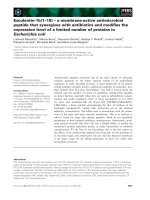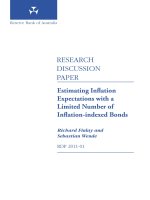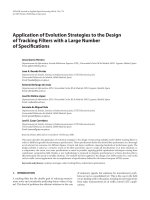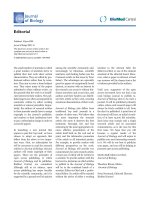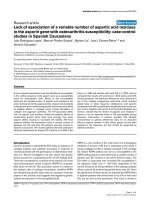In the oligopoly market, a small number of firms significantly influence each other the influence of each firm relates to the concept of prisoner dilemma that if one out of two firms
Bạn đang xem bản rút gọn của tài liệu. Xem và tải ngay bản đầy đủ của tài liệu tại đây (1.14 MB, 24 trang )
1
2
QUESTION 1:
1. Prisoner Dilemma
In the oligopoly market, a small number of firms significantly influence each other. The
influence of each firm relates to the concept of Prisoner Dilemma that if one out of two firms in
oligopolies takes the optimal action for itself, the outcome would be worse for both firms.
Moreover, if both firms take the optimal action simultaneously, the outcome would be the same
for both (McLaren 2012, p. 57).
Assumption
30
0
Profit in Autarky
60
Additional profit from export
18
0
22
0
Profit from the competition
Profit from the export plus
competition
Figure 1.1: Assumption and Profit following Prisoner Dilemma
(2) presents the case TS does not export but XD does, XD profit then will be 360 (300 Autarky
plus 60 export). In contrast, TS’s domestic profit reduces to 180 due to the market having new
competition. The case happens vice versa for (3). However, whether TS does export or not, the
optimal option of XD is to export since 360 is higher than 300 Autarky. If TS also chooses the
3
same strategy, XD and TS will meet at (4). That is when both firms trade simultaneously, both
earn 220 each instead of 360 because they earn from export but not as much as domestic losses
from the competition. Moreover, obviously making 220 is better than 180 (profit from doing
nothing and foreign firm are going to conquer the local market). In short, under free trade within
the situation of Prisoner Dilemma, regardless of the action of the competitor in the oligopoly,
both firms will take the dominant option that is to trade than do nothing, otherwise, the outcome
will be lower for both.
2. Cournot model and the welfare analysis
Assuming that marginal cost is 5000 USD, transportation costs for each unit is 1500 USD. Also,
assuming that the price of the car is the same in both countries since they share the same demand
curve and react based on the cournot model on that demand curve.
Case 1: No transportation costs
If there are no transportation costs, the surplus of the consumers will be increased since they can
consume with a lower price ($7500 > $6700) compared to autarky. Accordingly, the profits of the
firms will be decreased because even though they sell more cars (5/4m to 5/3m), the price of the
cars has decreased in larger degree ($7500 to $6700). The grey area in figure 1.2, total revenue,
had decreased from $3125 (Autarky) to
$2833
(Trade)
after
the
trade
without
transportation costs.
4
Figure 1.2: TS profit in Autarky and Trading with no transportation cost
Case 2: Transportation costs exist
Figure 1.3: Reaction function
5
Figure 1.4: Consumer surplus in Autarky vs Trade with transportation cost
Figure 1.5: Profit of TS in Autarky and Trade with transportation cost
Figure 1.6: Net welfare in trade
If there are transportation costs, consumer surplus increases and the firms’ profits decrease. In
this case, the reaction function of XD, figure 1.3, shows larger selling compared to that of
autarky(5/4mil to 17/12mil). Moreover, the price for the cars would be lowered from $7500 to
$7180. As seen on the figure 1.5 comparison, A will be the loss from the firms’ profits since they
lower the price from the autarky. Moreover, due to the transportation costs, they lose D.
However, compared to autarky, they export goods to each other, and they gain profits from
export revenue minus transportation costs, which is C.
Therefore, the consumer surplus will rise as depicted in figure 1.4. In autarky, deadweight loss is
higher than that of trade because firms are changed from monopolists who charge higher price to
their product, to participants of competition who make price based on equilibrium of market
supply and demand. Therefore, the price after trade will be lowered, hence deadweight loss
reduces and eventually beneficial for society welfare (figure 1.6).
QUESTION 2:
McLaren (2012) pointed out that a specific model is when the determinant of manufacturing
cannot be altered across industries. Also, there are few or all factors of manufacturing in the
model that are distinguished, and it can be known as a specific factors model (McLaren 2012).
Labor is a mobile factor that can motivate freely through 2 industries.
Assuming that land-A and capital-K are specific since each kind of capital and land are made for
a particular manufacturing process, textile requires (labor) L and (capital) K and sugar requires
land-A and labor-L. Profit-maximizing conditions require both sectors to choose the output level
since labor usage level as wage should be equal to the MVPL of both industries (w =
pSMPLS(LS/A) = pTMPLT(LT/K)).
Nevertheless, if an administration does not dictate the tariff on imported products, the demand of
consumers will be higher, which means that they will ask the government for their demand
satisfaction. Moreover, due to the domestic supply being low, there is an existence of excessing
demand. Based on Toppr (n.d.), when consumers seek for lower-price products and competition
between customers occurs, it leads to a rise in prices. Thus, other suppliers will take advantage of
hoping to gain more profit from it.
7
Figure 2.1: Equilibrium with the mixed specific-factors model
Figure 2.2: Effect of Tariff
Because Sugar industry in Vietnam has a comparative disadvantage, we should import sugar and
Vietnam will export their comparative advantage product is textile (McLaren 2012). Thus, when
the government imposes a tariff on imports that affect consumer price p S, pT is unchanged.
8
Suppose that the government reduces the import tariff by 50%, makes p S decrease by 50% and
that shifts the MVPLS to the left proportionally by 50% and meets at point Y. However, the new
equilibrium (Z) went up and to the left compared to Y. Thus, the wage declined but less than
50%. Due to the decline of tariff, the wage decreased to W’ but the real wage in respect of sugar
increases to
W'
0.5 p S
so the sugar intercept after reducing tariff is greater than its current tariff.
Since pT is unchanged, the real wage regarding textile
W'
pT
decrease so the textile intercept
after reducing the tariff is smaller than its current tariff.
Sugar
w’/Ps
w/Ps
Free worker’s budget
line after reducing
tariff
Free worker’s budget
line under old tariff
w’/PT
w/PT
Textile
Figure 2.3: The effect of reducing tariff on the free-worker’s budget lines.
Thus, the free workers have both higher and lower utility after reducing tariffs. Noticeably,
looking at figure 3, the more essential in the consumption bundle of textile the more likely that
they are worse-off and the more essential in the consumption bundle of sugar the more likely that
they are better-off.
Considering the welfare of workers and firms, the boundary of the area of Vietnam farmer’s
sugar income in figure2 shifts down by 50% and the lower boundary also shifts down but less
than 50% so the whole area would decrease less than 50%. Thus if the Vietnam farmer’s sugar
9
income denote by IS so
IS
decreased and the pT is remained so
S
p
IS
decreased. The budget
T
p
line of Vietnam farmer’s was shifted in.
Figure 2.4: Vietnam farmer’s budget line
10
Figure 2.5: Vietnam capitalist’s budget line
pS decreases while pT is unchanged so Vietnam capitalist’s income increases in terms of both
goods, thus the budget line shifts outward.
Figure 2.6: Welfare effects
11
According to The Worldbank (2020), Vietnam’s GDP is around $200billion compared to the
world’s GDP is nearly $85trillion so Vietnam is considered as a small country compared to the
world’s economy. Following figure12, tariffs make Vietnam's sugar industry overproduction and
underconsumption which are social welfare costs to Vietnam and gain from terms-of-trade
benefit. However, as a small-eco, its gain is not large enough and likely to-be insignificant or not
better-off to the whole eco-development. However, the reason that the Vietnam government
should maintain tariffs or accept the appeal of the Association of Sugar Products of Vietnam
selling protection to the interest group. The government is a part of sugar producers- the biggest
gain by tariffs. They maximize not social welfare but put more weight on social welfare of the
interest group relative to the products which were imposed by tariffs. Nevertheless, in the longterm when our sugar industry becomes larger, reducing the tariff or even no tariff to gain termof-trade benefit. Hence, in 2007 Vietnam join FTAs with Euro and become the largest exporters
goods of among 10ASEAN countries to EU since 2015 that support Vietnam effort to enhance
the economy for benefit of their people (Delegation of the European Union to Vietnam 2019).
QUESTION 3:
1. Vietnam’s trading partner
Based on the total value of import and export of Vietnam, Japan is one of the top 10 leading
countries which trade with Vietnam in 2018 (OEC n.d.), which accounts for 7.9% out of the sum
of value trade (Best Care Shipping 2015).
2. Skilled or unskilled labor abundant
According to McLaren (2012), the skilled labour is the worker with a college degree. The
percentage of workers who have college degrees in Japan in 2010 is 83% of the total population
of Japan (OECD n.d.). However, that of Vietnam in 2013 is 26% of the total population of
Vietnam. (OECD n.d.) Moreover, based on OEC (n.d.) the most specialized products of Vietnam
are mainly ingredients for food, fabric and goods that need low-level of processing. However,
those of Japan tend to be more focused on goods that need more sophisticated levels of
processing like chemicals and watch movements. Therefore, with these two pieces of evidence,
Japan is more focusing on skilled labour than Vietnam.
12
Figure 3.1: Most-specialized-products of Vietnam and Japan (Source: OEC, n.d.)
3. Heckscher-Ohlin model
McLaren (2012) pointed out that the Heckscher-Ohlin model (HOM) is the easiest way to
determine the labor market’s problems affected by globalization. HOM can be understood as a
comparative advantage model between countries (McLaren 2012). Also, it is acknowledged that
whether countries are abundant in which factors, they may manufacture and export their
incentives products.
Based on VnEconomy (2018), Vietnam exports textile; kinds of transport and replaced parts;
equipment and tools; seafood; wood products - which are primarily exported products to Japan.
Trinh (2020) indicated that the textile industry is one of the key sectors in Vietnam representing
16% of GDP. Furthermore, Koushan (2018) stated that lack of skilled-employment is one of the
key factors that Vietnam’s labor market is faced. The shortage of technology, vocational and
technical skills lowers Vietnam competitiveness and decreases economic growth (Koushan
2018). Hence, according to the Heckscher-Ohlin model (HOM) theory, Vietnam’s textile industry
is known as an unskilled labor abundant which exports unskilled-incentives goods.
13
Moreover, machinery and equipment, computers and electronics devices (industrial field);
plastics items; iron and steel are products exported to Vietnam by Japan (VnEconomy 2018).
According to Nordea (2020), an industrial sector - one of the main fields in Japan, which ranges
from paper to biotechnology or artificial intelligence, accounting for 29.1% of GDP. Nordea
(2020) also declared that Japan is a home of manufacturing electronic items. Also, this industry
plays an essential role for the country's modernization and industrialization (International Labour
Organization 2014). In short, based on the concept of HOM, Japan’s industrial sector is
acknowledged as a skilled labor abundant which imports skilled-incentives products.
4. Samuelson-Stolper Theorem
Figure 3.2: Gini index of Vietnam in the last 20 years
Figure 3.3: Gini index of Japan in the last 20 years
14
Figure 3.4: Japan export of Machinery and Equipment
Samuelson-Stolper Theorem is the case when a country trades, income of abundant factor
increases while income of scarce factor decreases resulting in increased inequality (McLaren
2012). Vietnam and Japan had an opposite level of Gini index that Vietnam reached the highest
of 39.3 in 2010 while Japan slump to the lowest of 32.1 in 2011 (figure 3.2, 3.3). Regarding
Vietnam with unskilled-labor abundant, textiles - incentive goods of Vietnam was export the
most (up 23% from 2009 to $9.2 billion) (Vietnam Trade Promotion Agency 2011) which means
the aggregate demand of textile increase lead to relative price increase, hence benefit the
unskilled labor to raising their income and hurts income of skilled workers. As a result, making a
greater gap in income distribution among abundant and scarce labor. Regarding Japan, due to
change in educational policy and an aging population, the supply and demand have increased
simultaneously which make the relative price for skilled workers stay the same (Kawaguchi and
Mori, 2018) while income minimum wage also increases (Mitsumaru K et al 2016) which is
more beneficial for lower-wage workers. Thus, income inequality falls eventually. Until 2010,
skilled-intensive goods exports decreased (figure 3.4) due to Japan's economy being hard hit by
Tsunami (Associated Press 2011), which hurt the relative skilled wages to decrease, hence the
Gini index fell to the lowest. In short, change in income distribution is the effect of trading
among two countries in which the increase of abundant labor’s wage affects the scarce labor’s
wage.
15
REFERENCES LIST:
Associated Press 2011, ‘Japanese earthquake and tsunami causes fall in exports’, The
Guardian,
20
April,
viewed
18
Dec
2020,
< />
Best Care Shipping 2015, Vietnam’s 10 biggest trading partners, Best Care Shipping, viewed
15
December
2020,
< />
16
partners#:~:text=China%20is%20Vietnam's%20leading%20trading,country's%20total
%20imports%20and%20exports.>
Delegation of the European Union to Vietnam 2019, GUIDE TO THE EU-VIETNAM
TRADE AND INVESTMENT AGREEMENTS, Delegation of the European Union to Vietnam,
viewed 19 December 2020, <Guide to the EU-Vietnam free trade agreement (europa.eu)>
Fred,
2020,
GINI
Index
for
Japan,
Fred,
viewed
18
Dec
2020,
< />
International Labour Organization 2014, SKILLED LABOUR A determining factor for
sustainable growth of the nation, International Labour Organization, viewed 19 December
2020, <wcms_428969.pdf (ilo.org)>
Koushan, D 2018, ‘Labor Market Trends in Vietnam’, Vietnam Briefing, 29 June, viewed 18
December
2020,
< />
vietnam.html/>
Kawaguchi Daiji & Mori Yuko 2008, Stable Wage Distribution in Japan, 1982-2002: A
Counter Example for SBTC?, Discussion papers 08-E-020, Research Institute of Economy,
Trade and Industry (RIETI).
Mitsumaru K et al 2016, The Gini Coefficient and Economic Inequality in Japan , Daiwa
Institute
of
Research,
viewed
18
Dec,
2020,
< />
McLaren, J 2012, International Trade, Wiley, ProQuest EBook Central database.(p89)
17
Nordea 2020, The economic context of Japan, Nordea, viewed 19 December 2020,
< />vider_sticky=oui>
Nordea 2020, Foreign trade figures of Vietnam, Nordea, viewed 19 December 2020,
< />
OEC
n.d.,
Profile
country
-
Vietnam,
OEC,
viewed
15
December
2020,
<ld/en/profile/country/vnm>
OECD n.d., World Indicators of Skills for Employment : Country tables; Japan, OECD,
viewed 19 Dec 2020, < />
OECD n.d., World Indicators of Skills for Employment : Country tables; Vietnam, OECD,
viewed 19 Dec 2020, < />
OEC n.d., Profile country - Japan, OEC, viewed 15 December 2020,
Trinh, N 2020, ‘Seizing Investment Opportunities in Vietnam’s Garment and Textile
Industry’, Vietnam Briefing, 7 August, viewed 18 December 2020, < />
18
Trading Economics, 2020, Vietnam - GINI Index, Trading Economics, viewed 18 Dec 2020
< />
Trading Economics, 2020, Japan Exports of Machinery & Transport Equipment, viewed 18
Dec 2020, < /><ld/en/profile/country/jpn>
The Worldbank 2020, GDP(constant 2010 US$) -Vietnam, The Worldbank, viewed 16
December 2020,
< />
The Worldbank 2020, GDP(constant 2010 US$) - World, The Worldbank, viewed 16
December 2020,< />
Vietnam Trade Promotion Agency, 201, Vietnam’s textiles and garments export in the first 9
months
of
2011,
viewed
18
Dec,
2020
< />
option=com_content&view=article&id=1052:vietnams-textiles-and-garments-export-in2000-first-9-months-of-2011&catid=270:vietnam-industry-news&Itemid=363>
VnEconomy 2018, ‘Japan became the fourth largest trading partner in Vietnam’, VJCC, 8
June, viewed 18 December 2020, < />
19
APPENDICES:
Calculation for question 1b
20
Appendix 1
21
Appendix 2
22
Appendix 3
23
Appendix 4
24


